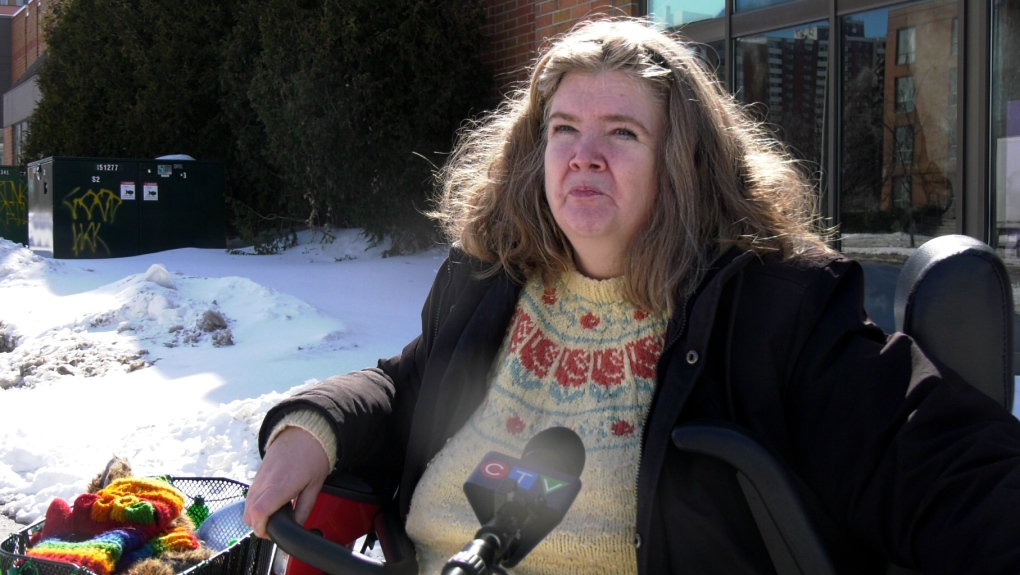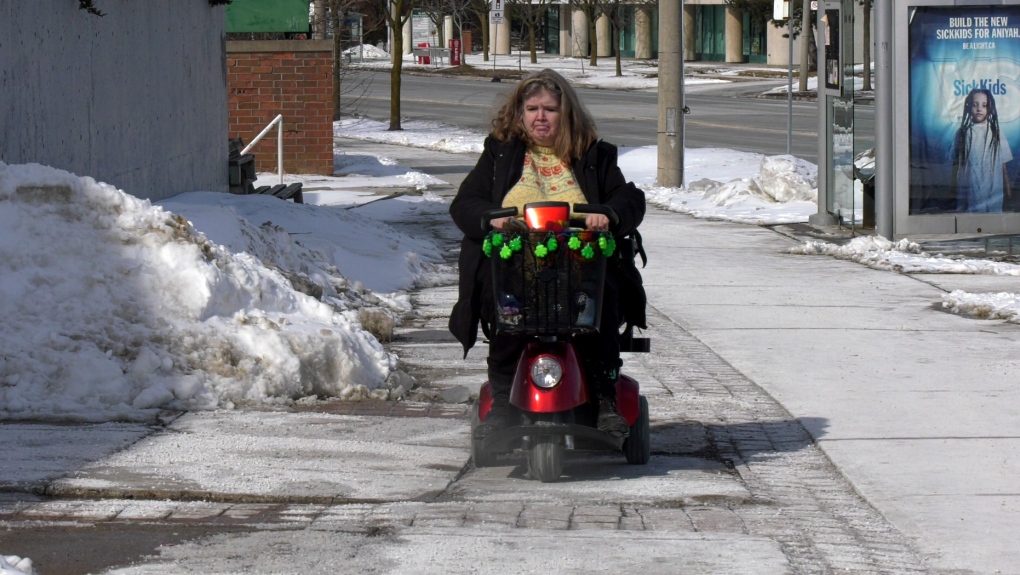Toronto woman who suffered concussion after fall from mobility scooter says city snow clearing protocols need review
A Toronto woman she says fell from her mobility scooter and got a concussion due to a poorly cleared sidewalk while trying to get groceries about ten days after the city saw a major snowfall in January.
Susan Hutchinson is calling for city crews to prioritize people with disabilities in the clearing of snow and make sure that when they do clear the path, what they leave behind is accessible — a recommendation echoed by a city committee this month.
“The sidewalk wasn’t cleared and I was going over really rough terrain,” she said. She said she was headed to get groceries near Malvern Town Centre on Jan. 28.
Hutchinson said she was following the path of a city plow that had veered off course and onto the uneven pavers on the mall’s property. She said her wheels slipped and she tumbled out of the scooter, receiving a concussion from the fall.
“It was sheer panic. I already have a spinal disability. I was nearly paralyzed once. My first thought was, ‘Cover my head.’”
 Susan Hutchinson (Jon Woodward/CTV News Toronto)
Susan Hutchinson (Jon Woodward/CTV News Toronto)
The City of Toronto confirmed it received a complaint from Hutchinson about her fall.
“The Municipal Licensing and Standards is investigating and addressing the damaged condition of the cobblestone path and concrete sidewalks, which are on private property. Since this is an ongoing investigation, additional information cannot be provided at the moment,” a city spokesperson said in a statement to CTV News Toronto.
The statement said all property owners are required to repair and maintain their property, and clear ice and snow within 24 hours after snowfall ends. Malvern Town Centre didn’t respond to inquiries from CTV News Toronto.
The City of Toronto previously said crews and contractors were working 24 hours a day to dig the city out of the January snowfall, which was the most snow seen in at least a decade. Cold weather meant the snow did not melt, and so tens of thousands of tonnes had to be trucked away.
 Susan Hutchinson (CTV News Toronto)
Susan Hutchinson (CTV News Toronto)
After the snowfall, those with mobility challenges had to make a choice: take the risk of going outside in a potentially hazardous situation or stay home.
“It was almost impossible,” Jean Williamson, who uses a mobility scooter, told CTV News Toronto Monday. “This is the first time in six weeks I’ve been able to get out on my own.”
Toronto’s Accessibility Advisory Committee is calling for the city to target areas that people with mobility issues or seniors use, to respond quickly to service requests even during “black-out” periods, and to have standard levels of service for major winter storms that leave huge amounts of snow.
“Rather than let it be chaotic or undefined when it comes to 35 cm of snow or 50 cm of snow, determine how long it’s going to take. Do the math, figure it out and get it done. Don’t leave us waiting for weeks on end,” committee chair and Toronto city councillor Kristyn Wong-Tam said in an interview with CTV News Toronto.
According to a committee presentation, city officials had prepared for four storm types. Storm type 1 is under 5 cm of snow, storm type 2 is between 5 and 15 cm, storm type 3 is between 15 and 25 cm and storm type 4 is over 25 cm.
The committee recommended that the 2023 budget process ensure the city can meet revised levels of service for two new categories — above 35 cm of snow and above 50 cm of snow.
It also recommended that the city target certain areas in the way Sweden targets daycares, schools and other areas in what that country calls a “Gender Equal Plowing Strategy.”
“What that does is prioritize vulnerable road users and sidewalk users,” Wong-Tam said.
“They created a program where all municipalities clear a pathway to daycares, schools, and transit stops first. Right now we go the other way, we take care of the cars first and the people last.”
CTVNews.ca Top Stories

Canada could impose tariffs on U.S. steel, orange juice in response to Trump threat
Canadian officials are narrowing a list of American products to target in the event the federal government must respond to U.S. tariffs on Canadian goods, CTV News has confirmed.
Convicted Jan. 6 rioter arrested as fugitive in Whistler, B.C.
An American citizen convicted of participating in the Jan. 6, 2021, riot on Capitol Hill who said he was seeking asylum in Canada has been arrested as a "fugitive from U.S. justice," according to authorities.
Can the U.S. really make Canada the 51st state?
Talk of Canada becoming the 51st American state has raised an existential question on this side of the border: Could it be done? Could the maple leaf make way to the stars and stripes? According to several experts, it may be possible, but not painless.
L.A. wildfires continue to devastate area, Canada prepared to offer expertise
A series of wildfires are searing through the Los Angeles area, forcing many to evacuate their homes. Here's everything that happened throughout Jan. 8.
'True when I said it, true today': former Canadian PM Harper pushes back against Trump on social media
Former Canadian Prime Minister Stephen Harper doesn’t find president-elect Donald Trump’s jibes about Canada becoming the 51st U.S. state very amusing.
Ontario Premier Doug Ford says he is 'OK' after OPP vehicle he was in was 'sideswiped' in Highway 401 collision
Ontario Premier Doug Ford was uninjured after an OPP vehicle he was travelling in was involved in a collision on Highway 401 earlier today.
At least 60 University of Guelph students sick as 'cluster of illness' hits residence
The University of Guelph is dealing with what they are calling a ‘cluster of illness’ among students living in residence.
Energy minister 'committed' to consumer carbon tax as he considers Liberal leadership
Energy and Natural Resources Minister Jonathan Wilkinson says he would be 'committed' to the consumer carbon tax should he become Liberal leader and prime minister, despite the policy’s unpopularity.
New ranking suggests Canada passport among 'top 5 losers' in the world
A new global ranking may raise doubts about Canada's reputation of being open to other countries.
































